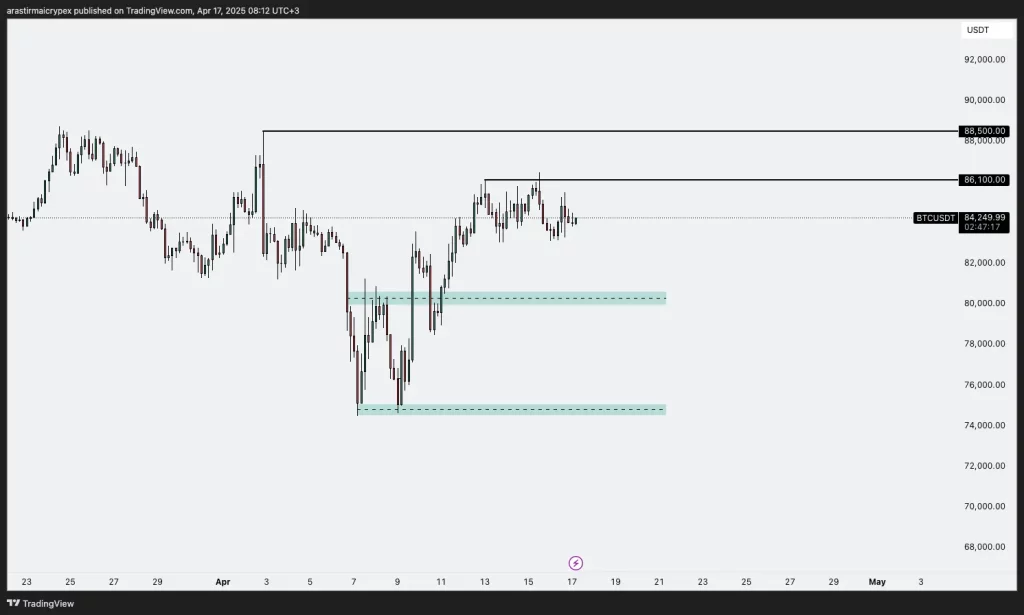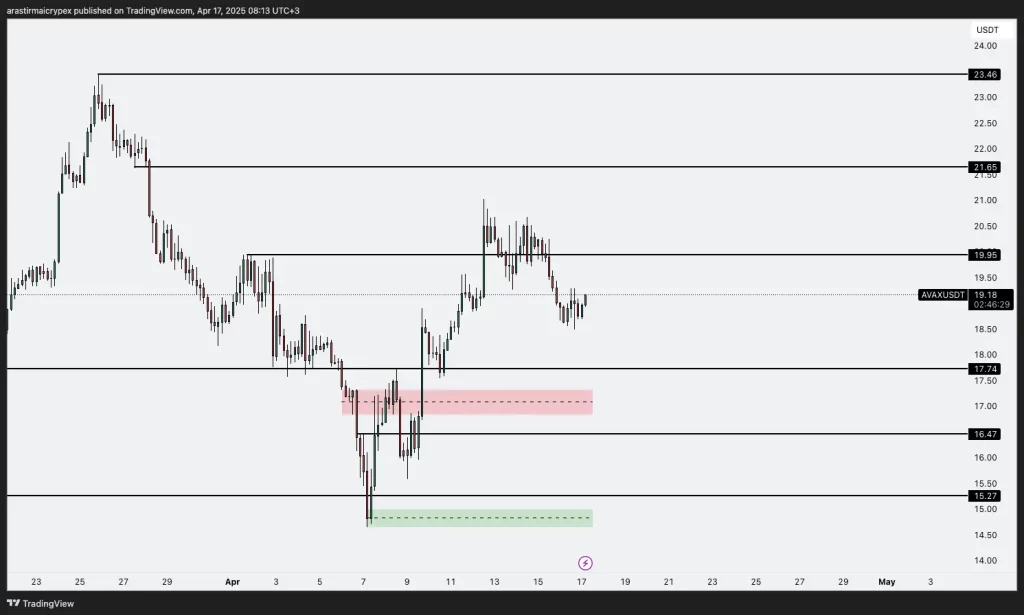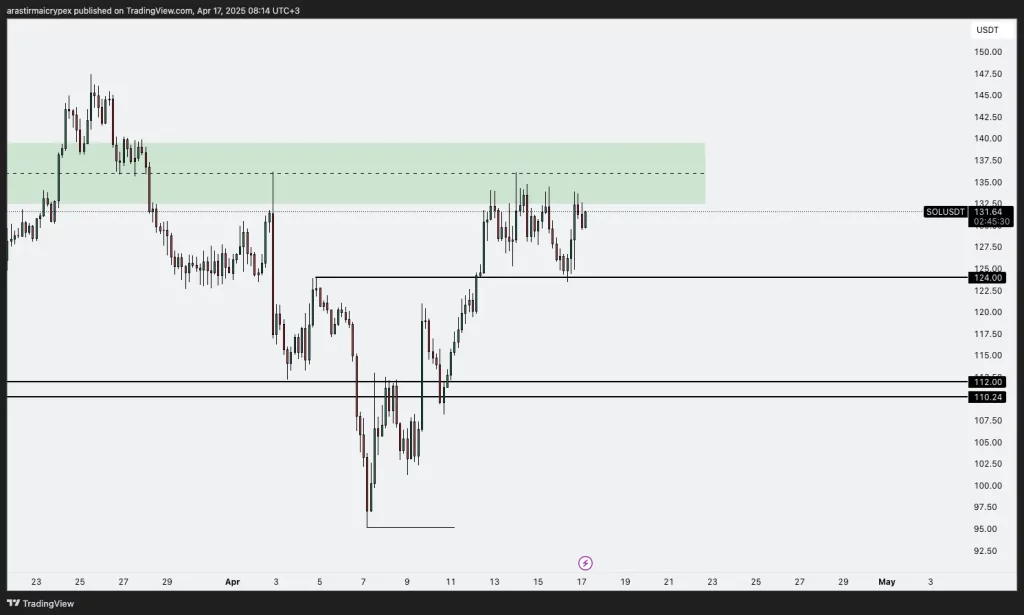Trump’s 245% China Tariffs and Nvidia’s Losses Shook Crypto – China Sells Confiscated Crypto
Trump’s 245% China Tariffs, Nvidia’s Losses Shook Crypto
Crypto and tech markets were rocked on April 16 by Trump’s announcement of new 245% tariffs on China and Nvidia’s $5.5 billion revenue warning.
Nvidia’s export restrictions on its H20 chips escalated US-China trade tensions, while the S&P 500 and tech stocks opened negative. Bitcoin is set to test the $81,000 support again.
While Coin Bureau rates such corrections as “healthy,” analysts agree that crypto volatility will continue until macro uncertainty becomes clearer.
China Sells Seized Crypto
According to Reuters, local governments in China are converting crypto assets seized from illegal activities into cash through private companies in order to fill public coffers against the economic slowdown. Although crypto trading is banned nationwide, working with intermediary companies for the sale of these assets is considered legal. In this process, digital assets worth billions of yuan are sold in foreign markets, while the foreign currency obtained is converted into yuan in local banks and transferred to public accounts.
Experts warn that the lack of regulation could lead to transparency problems and potential corruption risks. Judicial institutions have held many meetings recently to clarify the legal status of crypto assets. The People’s Bank of China also emphasized the need to strengthen crypto regulations at the international level in a report it published in December. China currently has the second largest national Bitcoin reserve in the world, with 190,000 BTC.
Fed Chair Powell Says “The Ground is Ripe for Stablecoin Regulation.”
US Federal Reserve Chairman Jerome Powell said that creating a legal framework for stablecoins is now a “good idea.” Speaking at the Economic Club of Chicago on April 16, Powell emphasized that digital assets are increasingly appealing to a wider audience and that consumer protection in this area has become critical.
Powell stated that such regulation had not been possible before following the crypto crashes experienced in the 2022-2023 period, but that there is now renewed movement in Congress on this issue.
President Trump’s crypto-friendly policies and the establishment of the Digital Assets Advisory Council have further increased the possibility of regulation. The new administration has put stablecoins on its priority legislative agenda. The bill, called the GENIUS Act, has passed the Senate, and the final text is expected to go before Trump in the next two months.
South Korea’s New Leader Candidate Emphasizes Crypto and Artificial Intelligence
Hong Joon-pyo, a presidential candidate for the right-wing People’s Power Party in South Korea, has vowed to liberalize local regulations as much as the Trump administration in the U.S. Hong has announced sweeping reforms to develop blockchain and virtual assets as “an industry.”
Hong, the former mayor of Daegu, plans to expand the use of blockchain in public services and invest 50 trillion won (about $35 billion) in R&D over five years in areas such as artificial intelligence, quantum technology and room-temperature superconductors. Hong’s pro-crypto stance signals a new era focused on technology in the country where political balances have changed after former President Yoon was removed from office shortly before the June 3 elections.
Russia’s Stablecoin Move
Osman Kabaloev from the Russian Ministry of Finance announced that the country should develop its own stablecoin after the US blocked USDT wallets linked to Russia. The freezing of approximately $30 million worth of USDT on the Garantex exchange accelerated discussions on local stablecoin production. This move is considered a critical step for Russian companies that want to trade cross-border with crypto against US and European sanctions.
The EU’s inclusion of Garantex on its sanctions list and the subsequent blocking of wallets by Tether caused the exchange to temporarily suspend its activities. During this period, Russia used USDT and Bitcoin in transactions such as oil trade with China and India. Russian authorities, who have distanced themselves from crypto domestically, continue to test the use of crypto assets in foreign trade.
Miners Sold More Than 40% of Their Bitcoin in March
Publicly traded Bitcoin mining companies sold more than 40% of the BTC they produced in March. This was the highest monthly sales rate since October 2024. According to TheMinerMag data, the sales of 15 major companies show that the accumulation strategy is being abandoned and the need for cash is increasing.
This wave of sales is linked to trade tariffs that have increased energy and hardware costs, rising inflation, and pressure from economic policies implemented by the Trump administration. Miners based in the US in particular say that the new 24% tariffs on hardware imports could jeopardize the industry’s profitability.
Experts predict that this could put pressure on Bitcoin prices and give mining companies outside the US a competitive advantage.
Oklahoma Shelved Bitcoin Reserve Plan
The Oklahoma Senate Tax Committee rejected the “Strategic Bitcoin Reserve Act” (HB1203), which would have the state treasury invest in Bitcoin, by a vote of 6 to 5. Although the proposal gained hope thanks to a senator who changed his mind at the last moment, it did not find enough votes. Thus, Oklahoma fell behind other states that have taken steps towards Bitcoin reserves, such as New Hampshire, Texas and Arizona.
While states such as New Hampshire and Arizona stand out in strategic reserve initiatives for Bitcoin, Oklahoma’s step back has led to states such as Montana, North Dakota and Wyoming, which have previously rejected similar proposals. There are currently 47 Bitcoin reserve bills in 26 states, 40 of which are still under active consideration.
Panama to Accept Crypto for Tax and Fee Payments
Panama announced that it will accept Bitcoin, Ethereum, USDC, and USDT for taxes and municipal fees. Mayor Mayer Mizrachi announced on April 15 that crypto payments will be instantly converted to dollars, enabling the system to be put into effect without the need for a new law.
The new system will cover a variety of municipal payments, from bus tickets to licenses. Panama thus joins cities such as Colorado, Lugano and Vancouver that have accepted crypto as an official means of payment.
This step aims to both accelerate the transition to the digital economy and create an investor-friendly city image.
DWF Labs Invests $25 Million in World Liberty
DWF Labs, one of the leading market makers in crypto markets, has invested $25 million in the Trump family-backed decentralized finance protocol World Liberty Financial (WLFI). This investment aims to support the liquidity of WLFI’s native token and the soon-to-be-launched USD1 stablecoin.
DWF Labs has also expanded into the US market, opening an office in New York. With this step, the company aims to deepen its relations with US regulators, establish collaborations with institutional investors and develop crypto education projects with universities.
The USD1 stablecoin is designed to be backed by short-term US Treasury bonds and cash collateral. WLFI positions USD1 as an “institutional-grade stable digital asset.”
———————————————————————————————
BITCOIN (BTC)
BTC is trading at $84,300 as of the morning hours with a 0.36% gain. It is trying to hold on to the 84,000 levels with the support it receives from the short-term demand zone created between 79,500 and 81,000. The price is currently trading close to the 86,100 resistance, but has not been able to permanently break out of this zone. In a possible breakout, the 88,500 level could be the new target. However, if the buying pressure weakens, a pullback to the major support zone around 81,000 and then 75,000 could be seen. A clear directional confirmation is required for the horizontal movement to end.

ETHEREUM (ETH)
ETH is priced at $ 1,595 with a 1.19% gain as of the morning hours. After being sharply rejected from the strong supply region in the 1700-1750 band, it continued its decline to 1580 levels. This region draws attention as an area where liquidity has concentrated and buyers have been weak in the past. While the price is currently consolidating in a horizontal structure, it is likely that this pressure will continue unless there is an upward break. While the 1768 and 1853 levels are monitored as critical resistance above, the 1530 – 1440 range stands out as the potential demand zone below. The direction will become clear after this consolidation process.

RIPPLE (XRP)
XRP is traded at $ 2.09 levels with a 0.45% gain as of the morning hours. It carried the rise it started from the 1.72 level to the 2.11 resistance, but it could not be permanent here and experienced downward pressure again. The price is looking for a balance around 2.09. Below, the 1.92 level is in the short-term support position, if this level is broken, the probability of a pullback to 1.72 increases. Above, the 2.23 level appears as the major resistance. Unless this zone is exceeded, a strong trend reversal should not be expected.

AVALANCHE (AVAX)
AVAX is trading at $ 19.18 as of the morning hours with a 2.24% loss in value. It exhibited a strong recovery up to the 19.95 resistance with the support it received from the 15.20 level. However, the price was rejected at this level and retreated somewhat. While the 17.75 level can be monitored as an intermediate support, if it remains below this level, the probability of a correction movement towards the 16.47 and 15.27 levels increases. In the upward break, the first target can be followed as 21.65.

SOLANA (SOL)
SOL is trading at $132 levels with a 0.53% gain as of the morning hours. It has limited the rise it started from the 110 level with the strong resistance in the 132 region. This region has worked as both a supply and liquidity area in the past, so the price reaction that will occur here is quite critical. If an upward break occurs, the 140-145 band can be targeted, while if the selling pressure increases, the 124 and 112 levels are potential support.
